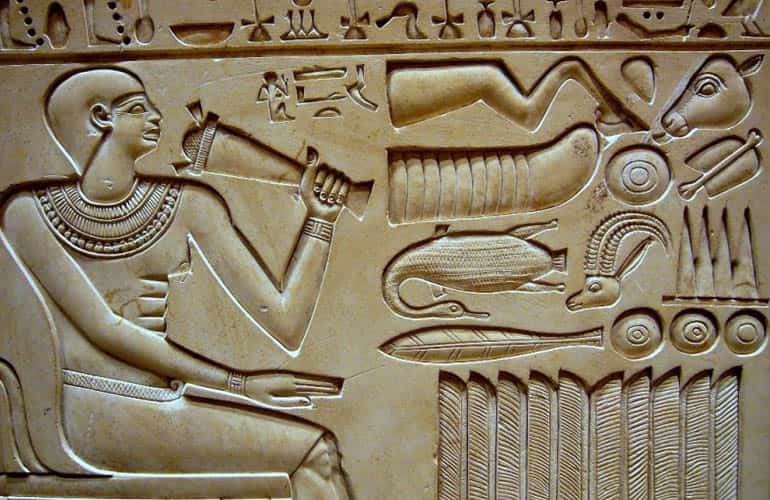The Middle Kingdom of Ancient Egypt:
The Middle Empire also called the Middle Kingdom ( 2050 – 1750 B.C.) began with the reunification of Egypt under Mentuhotep II, in the mid-Eleventh Dynasty of Egypt following Egypt’s First Intermediate Period.
The Eleventh Dynasty of Egypt were Kings from Upper Egypt (South Egypt), a Dynasty that built great temples, sent great expeditions for minerals and materials and built tombs for their young princesses and noble warriors who went north to fight.
The Eleventh Dynasty of Egypt disappeared after a succession of weak kings.
The Twelfth Dynasty of Egypt was founded by Amenemhat I, who had been the vizier of the last pharaoh of the XIth Dynasty, Mentuhotep IV.
Amenemhat I actively reinforced the centralism of the pharaoh by moving the capital from Thebes to Itjtawy Amenemhat I had son Senusret I as a coregent, to avoid problems of succession and to ensure that the succession was progressive. However, the end of Amenemhat I’s reign was violent; he was killed by a conspiracy.

the son of Amenemhat I the king Senusret I, who was a coregent from the twentieth year of his reign, succeeded him on the throne. He was one of the most powerful and efficient kings of this dynasty. While on a Libyan military campaign he learned of the murder of his father, Pharaoh Amenemhat I and had to return to Memphis.
Senusret I continued his father’s expansionist policy against Kush (Nubia) and expanded the southern border of Egypt to the fortress of Buhen near the second waterfall of the Nile. He also established diplomatic relations with the peoples of Syria and Canaanite.
The fortresses he built in the south were very solid and impressive, with interlocking beams inside the walls. They were forts on the transit routes from the south established to collect tribute. Also a pyramid and two obelisks in Heliopolis, one of which is still preserved.
Amenemhat II, who was coregent with Senusret I, became the later pharaoh. He was also a very good pharaoh, he sent an expedition. Objects with his name have also been found in Lebanon. During this period Egypt truly became an international power.
Amenemhat IV was the last king of the middle kingdom, this dynasty ends. Then comes a queen pharaoh, Sobekneferu, a sign of weakness and problems in ancient Egypt.
After this dynasty, there is another collapse of Egypt.
The middle kingdom of ancient Egypt facts
Without a centralized government, the bureaucracy was ineffective, as the atomization of power was imposed. Egyptian art became more local, and no major burial complex was built. Religion also became democratic when the lower classes claimed privileges previously reserved only for royalty. For example, they could use fragments taken from the Pyramid Texts on the walls of their coffins or tombs.
Although the Middle Kingdom of Egypt (2134-1570 BC) dates back to the 11th Dynasty, it begins with the reunification of the territory by Mentuhotep II The first sovereigns of the dynasty tried to extend their control from Thebes to the north and south at the same time.
Mentuhotep II ruled for more than 50 years, he maintained stability and control throughout the kingdom. He replaced some nomos and limited the power of the nomos, which was still considerable. Thebes was its capital, and its burial temple at Dayr al-Bahari incorporated traditional and religious elements; the tomb was separated from the temple and there was no pyramid in the Middle Kingdom of Egypt.
The reunification of the Middle Kingdom of Egypt
The reign of the first pharaoh of the twelfth Dynasty of Egypt, Amenemhat I, was peaceful. He established a capital near Memphis and, and favored national unity.
Ancient Egypt has divided administratively into three geographical units, each controlled by an officer under the supervision of a vizier and did not recognize any of the provincial nobles. Amenemhat III continued the policy of his predecessors and expanded land ownership reform. The TAIBAH kings initiated a vigorous cultural revival. The architecture, art, and jewelry of the period reveal an extraordinary delicacy of design, and the period is considered the golden age of Egyptian literature.
The rulers of the 13th Dynasty, approximately 50 in 120 years, were weaker than their predecessors, although they still maintained control of Nubia and the administration of the century-old government.






